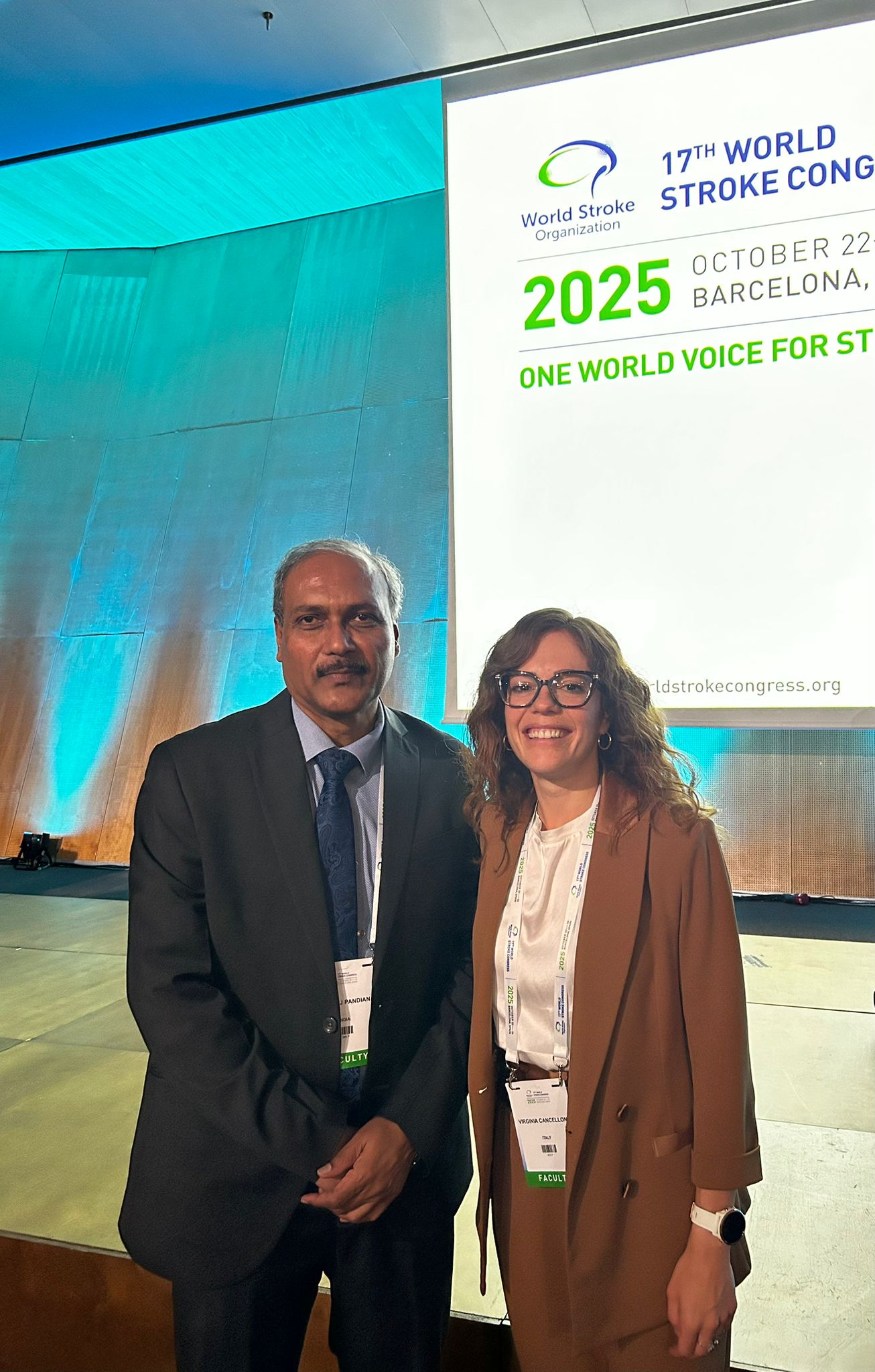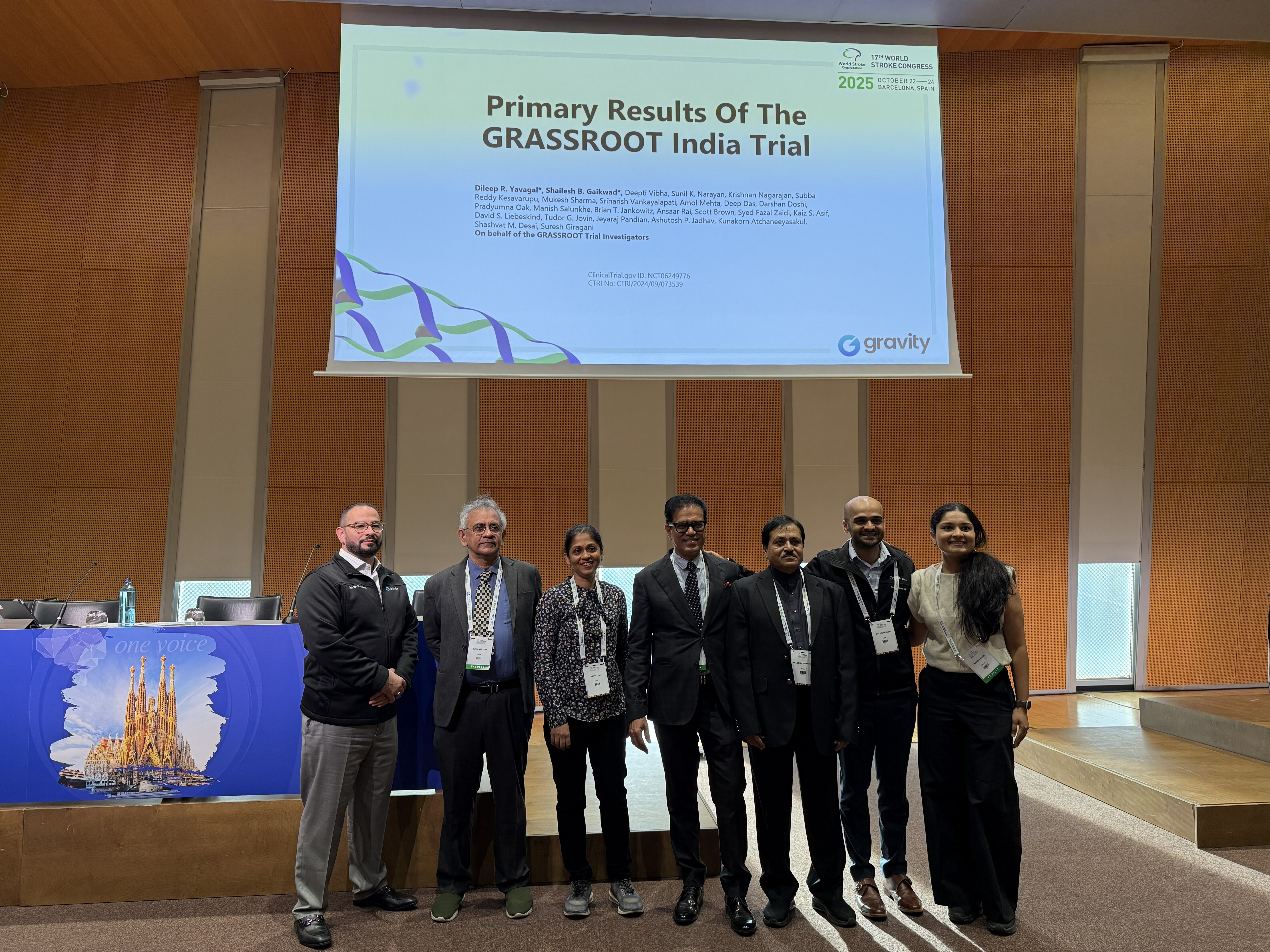Day 2 Clinical Trials Highlights at WSC 2025
Factor Xia (FXIA) Inhibition with Asundexian After Acute Non-Cardioembolic Stroke or High-Risk Transient Ischemic Attack (TIA): Methods and Baseline Data for the Oceanic-Stroke Trial
prepared by Virginia Cancelloni, Future Stroke Leader cohort III
Professor Mukul Sharma presented preliminary data on the OCEANIC-STROKE trial, including methods and baseline characteristics of participants.
Despite advances in stroke secondary prevention, recurrent ischemic events remain a major clinical challenge, particularly in patients with atherosclerotic disease.
This study evaluated the factor XIa inhibitor asundexian for secondary prevention after acute non-cardioembolic ischemic stroke or high-risk transient ischemic attack (TIA).
These are the first results from ongoing international randomized controlled trials investigating FXIa inhibition in this setting. This drug class is considered an attractive therapeutic target due to its potential to uncouple thrombosis from hemostasis, thereby reducing thrombotic risk without increasing bleeding. In the preceding Phase II PACIFIC-STROKE trial, asundexian 50 mg once daily demonstrated a favourable trend toward reduced recurrent ischemic events, particularly in patients with concomitant intra- or extracranial atherosclerotic disease.
OCEANIC-STROKE was a randomized, double-blind, placebo-controlled, event-driven Phase III trial comparing asundexian 50 mg once daily versus placebo, both on top of standard antiplatelet therapy, in patients with acute non-cardioembolic ischemic stroke or high-risk TIA. Conducted across 703 sites in 37 countries, it represented a large effort in stroke secondary prevention.
The primary endpoints were recurrent ischemic stroke (efficacy) and major bleeding (safety). Secondary efficacy outcomes included all strokes, composite of cardiovascular death, myocardial infarction or stroke, ischemic stroke in the first 90 days, disabling stroke and all-cause mortality. Secondary efficacy outcomes included a composite of major and non-major bleeding, symptomatic intracranial hemorrhage, fatal bleeding and minor bleeding.
Patients aged≥18 years old and with non-cardioembolic ischemic stroke with an NIHSS score ≤15 or high-risk TIA (ABCD2 score≥6), with history or evidence of atherosclerosis and planned to receive antiplatelet therapy (single or dual) were included within 72 hours of symptom onset.
Major exclusion criteria included atrial fibrillation or cardioembolic sources requiring anticoagulation, ischemic stroke within 7 days of the index event, stroke following procedures or specific causes, end-stage renal disease, active non-trivial bleeding or recent significant bleeding.
Moving to the results, 12,327 participants were randomized between January 2023 and February 2025. Women comprised 33.3% and participants had a median age of 68 years. The largest regional representation came from Western Europe (39%) and Asia (29%), with 5% from South America.
Nearly all participants (95%) had an ischemic stroke as the index event, most commonly large-artery atherosclerosis (43%) or stroke of undetermined etiology (30%), according to the TOAST classification system. The median NIHSS score at presentation was 3.
As concerns acute reperfusion therapies, they were administered in 27% of participants, with 20% receiving intravenous thrombolysis only, 3% mechanical thrombectomy only, and 4% both treatments. At randomization, 62% of patients were receiving dual antiplatelet therapy with aspirin and a P2Y12 inhibitor.
The trial’s design and enrollment profile reflect strong global representativeness and adherence to contemporary standards of stroke care, including early reperfusion and dual antiplatelet use.
Upon completion, OCEANIC-STROKE will be the first Phase III superiority trial evaluating a factor XIa inhibitor for the prevention of recurrent ischemic stroke, marking an important step toward expanding therapeutic options in stroke secondary prevention.
By targeting factor XIa, asundexian introduces a novel mechanism that could reduce ischemic risk without substantially increasing bleeding—an unmet need in this population. The full efficacy and safety results, once available, are expected to provide evidence on whether FXIa inhibition can become a new standard of care in the secondary prevention of non-cardioembolic ischemic stroke.
ARPEGGIO Trial
prepared by Juen Kiem Tan
The ARPEGGIO study was presented by Dr Eva Mistry, Chief Investigator of the trial. The ARPEGGIO study is a double-blind, randomized, placebo-controlled, dose-ranging Phase IIa study, exploring the safety, tolerability and preliminary efficacy of scp776, a novel agent designed to selectively deliver insulin-like growth factor 1 (IGF-1) to apoptotic cells, in patients with acute ischaemic stroke (AIS) due to large vessel occlusion (LVO) within 24 hours of presentation. The trial was conducted across 20 sites in the United States. Participants received two intravenous doses of scp776, administered 24 hours apart. The primary outcome was to determine the safety and tolerability of scp776 in AIS patients treated with endovascular thrombectomy (EVT), while the secondary objective was to explore its preliminary efficacy. A total of 119 patients with LVO-AIS undergoing EVT were enrolled. Patients treated with scp776 demonstrated greater neurological improvement by discharge or day 7 after symptom onset, with an adjusted mean improvement of 2.26 points on the NIH Stroke Scale (NIHSS) compared with placebo (p = 0.066). Moreover, scp776 treatment was associated with a 15% higher relative rate of functional independence (modified Rankin Scale [mRS] score 0–2 at 90 days), suggesting a consistent benefit across multiple functional outcomes. Scp776 was generally safe and well tolerated, with comparable rates of serious adverse events between treatment and placebo groups. The most common drug-related adverse event was hypoglycaemia, consistent with scp776’s mechanism of action, and was effectively managed in all affected patients.
Impact of Catheter Ablation on Secondary Stroke Prevention in Patients with Atrial Fibrillation Receiving Edoxaban (STABLED Study)
Presented by: Yasuhiro Nishiyama, WSC 2025, Barcelona
Prepared by Ivy Sebastian
The STABLED trial, presented by Yasuhiro Nishiyama at the World Stroke Congress 2025 in Barcelona, evaluated the potential benefit of catheter ablation (CA) in improving secondary stroke prevention among patients with non-valvular atrial fibrillation (AF) already treated with edoxaban. Recognizing that AF is the most frequent cardiac arrhythmia contributing to stroke and heart failure, and that recurrent ischemic strokes persist despite oral anticoagulation, the study explored whether rhythm control through CA could offer incremental protection.
This multicenter, open-label, randomized trial was conducted between March 2018 and July 2021 across 52 Japanese centers, enrolling 251 patients aged 20–85 years with confirmed AF, a recent ischemic stroke within 1–6 months, and a modified Rankin Scale (mRS) score of 3 or less. All participants received edoxaban; they were randomly assigned to either standard medical therapy (n=124) or catheter ablation plus medical therapy (n=125). The primary endpoint was a composite of recurrent ischemic stroke, systemic embolism, hospitalization for heart failure, or all-cause death, with a follow-up duration of at least three years.
Although the primary composite endpoint was not statistically significantly reduced with catheter ablation, the results showed numerically lower event rates in the ablation group, indicating a favorable trend toward reduced recurrence and mortality. Crossovers occurred in both arms (12.9% undergoing ablation after randomization to medical therapy and 15.2% in the CA arm not ablated). Safety outcomes were reassuring, showing low rates of procedure-related complications and comparable bleeding risks to medical therapy alone. Subgroup exploration suggested more pronounced benefit in younger patients and those with persistent AF.
The investigators noted that the open-label design and crossover rate above 10% represented key study limitations, along with the modest sample size, which may have limited statistical power. Nonetheless, catheter ablation was safe and associated with trends toward improved cardiovascular outcomes. The trial concluded that rhythm control strategies using catheter ablation could complement anticoagulation for long-term vascular protection in AF patients with prior stroke, warranting confirmation through larger, adequately powered randomized studies.
OP045: Impact of an Artificial Intelligence-Based Model for Intracranial Aneurysm Detection on Patient Diagnosis and Outcomes: A Multi-centre, Double-Blinded, Sham-AI, Randomized Controlled Trial (IDEAL Study)
prepared by Sarah Matuja
Presented at the 17th World Stroke Congress 2025, the IDEAL study provides the first Level-I evidence from a double-blinded randomized controlled trial evaluating artificial intelligence (AI) in real-world radiology practice.
Led by Dr Zhao Shi (China), this multi-centre trial enrolled 6,470 participants from 21 tertiary hospitals across China. Patients undergoing head CT angiography were randomized to True-AI assistance (n=3,234) or Sham-AI (n=3,236).
Results showed that AI assistance improved diagnostic sensitivity from 79.7% to 92.3% (p<0.001) for intracranial aneurysm detection, while maintaining high specificity (97.1% vs 96.5%). The AI group also showed shorter reading times and greater detection of small aneurysms, without increasing unnecessary downstream procedures or adverse events.
The IDEAL trial delivers the first randomized, placebo-controlled evidence confirming that AI can safely enhance accuracy and efficiency in neuroimaging. These results highlight a paradigm shift toward evidence-based AI adoption in clinical radiology and set a new benchmark for future AI validation studies in stroke and neurovascular care.
Landmark Trial for India and LMICs: The GRASSROOT India Study
Prepared by Nishita Singh
The GRASSROOT India trial marks a turning point for stroke care innovation in resource-limited settings.
The trial was led by Dr. Dileep Yavagal (University of Miami) and Dr. Shailesh Gaikwad (AIIMS, New Delhi) and, this multicentre, single-arm study evaluated the Supernova stent retriever (Gravity Medical Technology Inc), a novel, cost-effective thrombectomy device, across multiple Indian centres. It demonstrated that the Supernova device achieved high reperfusion rates (mTICI ≥2B in 93.8%) with a safety profile comparable to leading international devices, meeting its primary endpoint. These findings confirm that advanced interventional stroke care can be delivered safely, effectively, and affordably within LMIC contexts.
Importantly, GRASSROOT India’s success has already led to regulatory approval of the device in India (August 2025) and this landmark achievement could pave the way for cost-effective thrombectomy programs across Asia, Africa, and Latin America.

